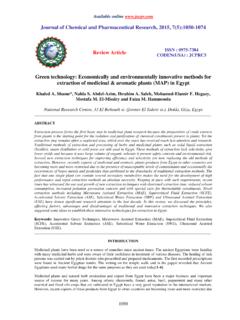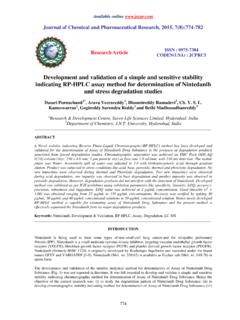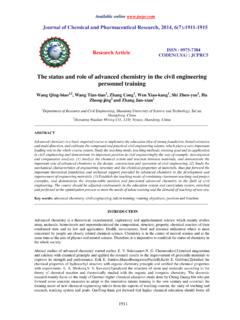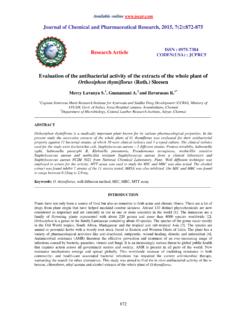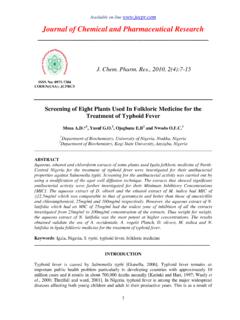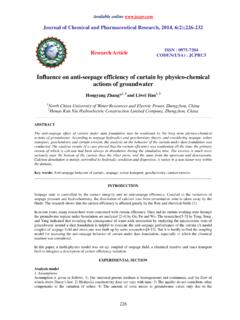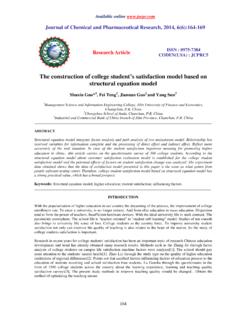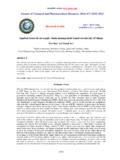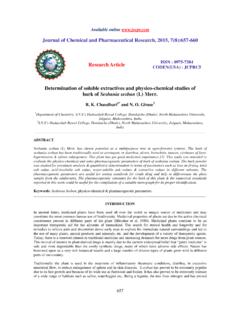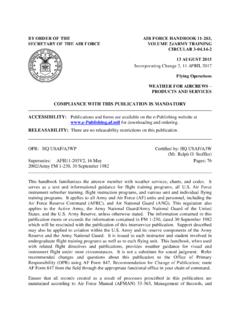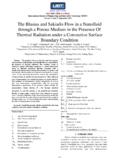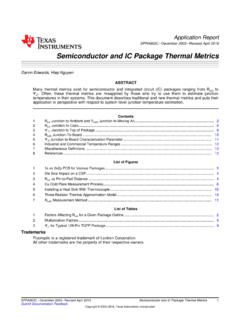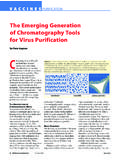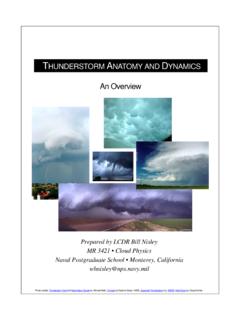Transcription of Journal of Chemical and Pharmaceutical Research, 2014, 6(2 ...
1 Available online Journal of Chemical and Pharmaceutical research , 2014 , 6(2):469-474. ISSN : 0975-7384. research Article CODEN(USA) : JCPRC5. The effects of reactor material and convective heat transfer coefficient on methane catalytic partial oxidation in a micro-channel Jing-yu Ran, De-xiang Yang and Li Zhang Key Laboratory of Low-Grade Energy Utilization Technology and Systems, Ministry of Education (Chongqing University), Chongqing, China _____. ABSTRACT. By using detailed reaction mechanism of CH4 catalytic oxidation on rh surface, the catalytic partial oxidation of low concentration CH4 was investigated numerically in a micro-channel focusing on the effects of reactor material and convective heat transfer coefficient on it. The results show that: the reactor with different reactor materials and h has the fixed effect on methane catalytic partial oxidation. First, methane conversion of the outlet is on ceramic reactor; XCH4 is , and in several other reactors.
2 The material of big thermal conductivity such as stainless steel, corundum, red copper produces bigger yield of CO and H2 than ceramic reactor. At the same time, high thermal conductivity has a problem of carbon deposition on the wall. Then, when h is 0 w m-2 k-1, the methane conversion efficiency reaches , yield coefficent of H2 reaches , yield coefficent of CO reaches The smaller h is, the more syngas we get in this reactor. In order to get more syngas and have stable combustion, just adopt the material of high thermal conductivity and keep the reactor adiabatic. Keywords: Reactor material; convective heat transfer coefficient; low concentration CH4; catalytic partial oxidation;. numerical investigation _____. INTRODUCTION. In recent years, with the development of micro fabrication technology and micro-electro-mechanical systems (MEMS). [1-2], more and more researchers are aware of micro burners as a promising type of portable energy device.
3 Micro burners have many advantages, such as the simple structure, long working life, easy fuel replacement, and providing powers from a number of microwatts to hundreds of watts. They have been widely applied to the military, aerospace, Chemical analysis, biomedical, environmental monitoring, digital electronic products and other fields. Due to the low concentration of methane hard to be on fire, many scholars put forward to join the hydrogen to promote fire. POM is a good way to produce H2, which has high efficiency. Because of the problem of Carbon deposition; we add a small amount of water vapor in the reactor [3-4] which coupled partial oxidation reaction. These measures are just adopted for good combustion. Now, many scholars have focused on POM. Sun Zhiwei et al [5] study the action of gravity on it by numerical methods. Carbon deposit has increased along the direction of gravity wall and reduced in the opposite direction.
4 Torniainen et al [6] suggested that CH4 has dissociation of carbon and hydrogen on the catalyst surface first, and then CO2. Yan qiangu et al [7] adopted the experiment to research the carbon deposit. Mallens [8] used TAP to study the POM, and they think the reaction of CO is quicker than CO2. Walter et al [9] thought that CH4 generated Cx and CHx firstly. Wang Haiyan [10] obtains the developing tendency of outcrop coal fire under the multi - ventilation powers and fire pressure. Ashok V and An. Palaniappan [11-12] research the kinetics and mechanism of oxidation and cyclization oxidation. Early some researches have played an important role to understand the methane/oxygen catalytic partial oxidation, but still 469. Jing-yu Ran et al J. Chem. Pharm. Res., 2014 , 6(2):469-474. _____. have some questions, such as reactor material and convective heat transfer coefficient which have effect on the production of synthesis gas.
5 This paper uses the numerical method to learn the low concentration of CH4 of partial oxidation reaction on Rh catalyst, focusing on reactor material and h on the characteristic of catalytic partial oxidation reaction of CH4. The reaction mechanism is analyzed with detail; it lays a theoretical foundation for the further study on the combustion system. 1 PHYSICAL AND MATHEMATICAL DESCRIPTION. Physical model The configuration of the 3-D micro-tube adopted in this paper is shown in The internal radius of the tube r0 is mm, the thickness of the wall is mm and the whole length of the tube L is 10 mm. Rh catalysts is assumed to be uniformly deposited on the smooth inner-wall with a density of 10-8 kmol m-2. The center of the tube entrance locates at the origin of coordinates, and the inlet velocity of the mixture gas is uniform at the entrance of the tube and positive with x-axis. Catalytic combustion occurs at the surface of catalyst, which the gas reaction rate is quite slow compared to gaseous combustion.
6 The schematic structure of circular tube Numerical models Though the micro-tube is millimeter-scale, its characteristic size is still much bigger than the average free distance of the reactant molecules. So it is reasonable to adopt continuum model in this paper. In addition, the body force term, dissipations and radiation of the gaseous species are neglected. The main governing equations are as follows. Continuum equation, ( u ) 1 (r v ). + + =0. (1). t x r r Momentum equation, ( u) ( uu) ( vv) P 4 u 2 1 (rv). + + = + [ . t x r x x 3 x 3 r r . (2). 1 v u + [ r ( + )]. r r x x ( v ) ( uv ) ( vv ) P v u + + = + [ ( + )] +. t x r r x x r . (3). 4 v 2 u v 2 v v [ ( + )] + ( ). r 3 r 3 r r r r r Energy equation of the gas phase, ki ( h) ( uh) ( vh) T 1 T Yk t +. x +. r = ( g ) +. x x r r (r g ) + (. r x h D x )+. k=1. k k . (4). ki ki Y. r . (. k=1. r h R M. hk Dk k ) . k=1. k k k Species equation of the gas phase, 470.]
7 Jing-yu Ran et al J. Chem. Pharm. Res., 2014 , 6(2):469-474. _____. ( Yk ) ( uYk ) ( vYk ) Y 1 Y. + + = ( Dk k ) + (r Dk k ) + Rk Mk ( k = 1, 2, , K i ). (5). t x r x x r r r Energy equation of the solid wall, ki + k j ( h) T 1 T. t = ( s x x )+. r r (r s r ) h S M. k =1. k k k . (6). The ideal gas and caloric equation of state, Ki Yk p = RT M. k =1 k . (7). D Diffusion coefficient (m2 s-1), p pressure, u, v Axial, radial velocities (m s-1), h Total enthalpy of the gas phase (J K-1g), Ki, Kj Total number of gaseous species and surface species, r Radial coordinate (m), x Axial coordinate (m), . Density (Kg m-3),Thermal conductivity(W m-1 K-1), Y Mass fraction, Viscosity (Pa s), Methane/oxygen equivalence ratio. Reaction mechanism In a millimeter-scale catalytic combustor, homogeneous reaction is generally ignored, since it will be inhibited by the use of catalysts. So only a heterogeneous mechanism is included in the calculation of this paper.
8 The detailed elementary heterogeneous mechanism of methane over Rh established by Deutschmann et al[13] is used in this paper. 2 CALCULATION METHOD AND MODEL VALIDATION. Laminar flow model and component transmission model is employed. The method for solving the problem is the SIMPLE algorithm. Import speed inlet boundary (the residence time of the gas mixture in the tube is much larger than the reaction time) and pressure outlet boundary are put to use. Inlet and outlet pressure are an atmospheric pressure. Inner wall uses the coupling wall. Wall has adopted different material in table one. These equations are used to have a detail on research . XCH4 represents methane conversion; WH2, WCO represents yield coefficient. 0. nCH nCH 4. X CH 4 = 4. 0. 100% . (8). nCH 4. nH 2. WH 2 = 100% . (9). 2 nCH 4 + n H. 0 0. 2O. nCO. WCO = 0. 100% . (10). nCH 4. Table 1 Property parameter values of different wall material project [w m-1 k-1] [kg m-3] Cp[J kg-1 k-1].
9 Ceramic 2 2600 1464. stainless steel 16 7200 615. corundum 32 3940 37. red copper 387 8978 381. To verify the accuracy of the dynamic model, the physical model which was used in the literature [14]by Alessandro Donazzi is used in this paper, and this paper adopted the same working condition such as it in the literature[15]. As shown in , the result between simulation and experiment has close agreement, so the mathematical model and reaction mechanism in this paper is correct. 471. Jing-yu Ran et al J. Chem. Pharm. Res., 2014 , 6(2):469-474. _____. 100 CO-experiment CO-simulation 80 H2-experiment Conversion efficiency(%). H2-simulation Mole fraction(%). 60. 40. CH4-experiment CH4-simulation 20 O2-experiment O2-simulation 0 600 700 800 900 1000 1100 1200 600 700 800 900 1000 1100 1200. Temperature(k) Temperature(k). Computing validation(reaction airspeed 4 106 Nl Kg cat-1 h-1, volume fraction of CH4 1%, volume fraction of O2 ).
10 RESULTS AND DISCUSSION. The effects of reactor material on methane catalytic partial oxidation The mixed gas is constituted by CH4, O2 and N2. N2 is an inert gas, and it does not participate in the reaction. Methane volume fraction is 5%; oxygen volume fraction is , water vapor volume fraction of 1%. Inlet pressure is 1atm, and the convective heat transfer coefficient is 1w m-2 k-1. Preheating temperature of the mixed gas is shown in and , for different wall materials, oxygen consumption rate has little change, because oxygen is diffusion controlled, and the temperature gradient of different reactor has a little effect on it. XCH4 (methane conversion) of the outlet is in ceramic reactor, XCH4 are respectively , and in several other reactors. The smaller the coefficient of thermal conductivity is, the higher the temperature of the oxidation zone is, and the lower the temperature reforming zone is on the contrary.
